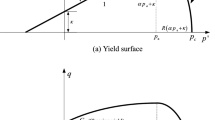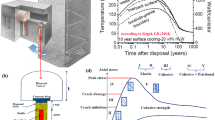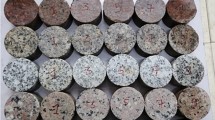Abstract
A detailed scientific study is required for the disposal of high-level radioactive wastes because they generate extremely high heat during their half-life period. Although, several methods have been proposed for the disposal of nuclear wastes, deep underground repository is considered to be a suitable option.
In this paper, field investigation has been done near to Bhima basin of peninsular India. Detailed fracture analysis near the borehole shows very prominent maxima of fractures striking N55∘E coinciding with the trace of master basement cover metasediment fault. Physico-mechanical properties of rocks have been determined in the laboratory.
The host rock chosen is granite and engineered barrier near the canister is proposed to be clay. A thermo-hydro-mechanical (THM) analysis has been done to study the effect of heat on deformations, stresses and pore-pressure variation in granite and clay barriers. For this purpose, finite difference method has been used. Suitable rheological models have been used to model elastic canister and elasto-plastic engineered barrier and host rock. It has been found that both temperature and stresses at any point in the rockmass is below the design criteria which are 100∘C for temperature and 0.2 for damage number.



















Similar content being viewed by others
References
Alonso E E, Alcoverro J, Coste F, Malinsky L, Merrien-Soukatchoff V, Kadiri I, Nowak T, Shao H, Nguyen T S, Selbadurai A P S, Armand G, Sobolik S R, Itamura M, Stone C M, Webb S W, Regeb A, Tijani M, Maouche Z, Kobayashi A, Kurikami H, Ito A, Sugita Y, Chijimatsu M, Börgesson L, Hernelind J, Rutqvist J, Tsang C F and Jussila P 2005 The FEBEX benchmark test: Case definition and comparison of modelling approaches; Int. J. Rock Mech. Min. Sci. 42 611–638.
Berchenko I 1998 Thermal loading of saturated rock mass: Field experiment and modeling using thermoporoelastic singular solutions; Dissertation, Minneapolis: University of Minnesota.
Booker J R and Savvidou C 1985 Consolidation around a heat source; Int. J. Rock Mech. Min. Sci. 9 173–184.
Chan T, Schair K, Jing L, Ahola M, Noorishad J and Vuillod E 1995 International comparison of coupled thermo-hydro-mechanical models of a multiple fracture benchmark problem: DECOVALEX phase I, Bench Mark Test 2, Int. J. Rock Mech. Min. Sci. & Geomech. Abstracts 32 435–453.
Chijimatsu M, Fujita T, Sugita Y, Amemiya K and Kobayashi A 2001 Field experiment results and THM behavior in the Kamaishi mine experiment; Int. J. Rock Mech. Min. Sci. 38 67–78.
Dutt A, Saini M S, Singh T N, Verma A K and Bajpai R K 2012 Analysis of thermo-hydrologic-mechanical impact of repository for high-level radioactive waste in clay host formation: An Indian reference disposal system; Environ. Earth Sci. 66 (8) 2327–2341.
EURATOM 2000 Full-scale engineered barriers experiment for a deep geological repository for high-level radioactive waste in crystalline host rock (FEBEX project). Report EUR 19147, Directorate-General for Research, European Commission, rue de la Loi/Wetstraat 200, B-1049 Brussels.
Graham J, Chandler N A, Dixon D A, Roach P J, To T and Wan A W L 1997 The buffer/container experiment: Results, synthesis, issues, Atomic Energy of Canada Limited Report, AECL-11746, COG-97-46-1. AECL, Ontario, Canada.
Guo R. and Dixon D. 2006 Thermohydromechanical simulations of the natural cooling stage of the Tunnel Sealing Experiment; Eng. Geol. 85 313–331.
Guvanasen V 1985 Development of a three-dimensional finite element code and its application to geoscience research, 17th Information Meeting of the Nuclear Fuel Waste Management Program, Atomic Energy of Canada Limited, Technical Report TR-299, AECL, Ontario, Canada.
Hoek E, Carranza-Torres C and Corkum B 2002 Hoek–Brown Failure Criterion – 2002 edn, Proc. NARMS-TAC Conference Toronto 1 267–273.
ISRM 1981a Rock characterization testing and monitoring; In: ISRM suggested methods, Int. Soc. for Rock Mech. 211p.
ISRM 1981b Suggested method for determining the uniaxial compressive strength of rock materials, rock characterization, testing and monitoring; Int. J. Rock Mech. Min. Sci., Geomech. Abstr, 113p.
Jing L, Tsang C-F and Stephansson O 1995 DECOVALEX – An international co-operative research project on mathematical models of coupled THM processes for safety analysis of radioactive waste repositories (special issues on THM coupling in rock mechanics); Int. J. Rock Mech. Min. Sci. 32 387–398.
KAERI 2005 Long-Term Heat Load Calculation Methodology for Spent Nuclear Fuel; Korea Atomic Energy Research Institute, KAERI/TR-3031/2005.
Kjartanson B H and Gray M N 1987 Buffer/Container Experiments in the Underground Research Laboratory; Proceedings of the 40th Canadian Geotechnical Society Conference, Regina, SK.
Ledesma A and Chen G J 2003 T-H-M modelling of the Prototype Repository Experiement: Comparison with current measurements; In: Proceedings of the International Symposium on Large Scale Field Tests in Granite (eds) Alonso E E and Ledesma A, Sitges, Barcelona, Spain, 12–14th Nov. 2003, Advances in Understanding Engineered Clay Barriers, Balkema, pp. 339–346.
Mathur R K, Narayan P K, Joshi M R and Rakesh R R 1998 In situ multi-heater thermomechanical experiments in Mysore Mines, Kolar gold fields, Bhabha Atomic Research Centre, Mumbai, India, BARC/1998/I/015.
Radhakrishna H S, Crawford A M, Kjartanson B H and Lau K C 1992 Numerical modelling of heat moisture transfer through bentonite-sand buffer; Canadian Geotech. J. 29 1044–1059.
Raj K, Prasad K K and Bansal N K 2006 Radioactive waste management practices in India; Nuclear Engineering and Design 236 (7–8) 914–930.
Rutqvist J, Barr D, Datta R, Gens A, Millard A, Olivella S, Tsang C F and Tsang Y 2005 Coupled thermal-hydrological-mechanical analyses of the Yucca MountainDrift Scale Test – Comparison of field measurements to predictions of four different numerical models; Int. J. Rock Mech. Min. Sci. 42 680–697.
Sillen X 2008 Modelling the thermal impact of a repository for high-level radioactive waste in a clay host formation, COMSOL Conference – Hannover 2008.
Stephansson O, Hudson J A, Tsang C -F, Jing L and Anderson J 1999 DECOVALEX II Project: Coupled THM issues related to repository design and performance – Task 4. SKI Report 99:7.
Thomas H R, He Y, Sansom M R and Li C R W 1996 On the development of a model of the thermo-mechanical-hydraulic behaviours of unsaturated soils; Eng. Geol. 41 197– 218.
Thomas H R, He Y and Onofrei C 1998 An examination of the validation of a model of the hydro/thermo/ mechanical behaviour of engineered clay barriers; Int. J. Num. Anal. Meth. Geomech. 22 49–71.
Thomas H R, Cleall P J and Melhuish T A 2003 Simulation of the Tunnel Sealing Experiment using THM modelling; No. 06819-Rep-01200-10112-R00, Ontario Power Generation Inc., Nuclear Waste Management Division Report, Toronto.
Verma A K, Bajpai R K, Singh T N, Narayan P K and Avi Dutt 2010 3D instability analysis of an underground geological repository – An Indian case study; Arabian J. Geosci., doi: 10.1007/s12517-010-0131-4.
Verma A K, Saini M S, Singh T N, Avi Dutt and Bajpai R K 2013 Effect of excavation stages on stress and pore pressure changes for an underground nuclear repository; Arabian J. Geosci. 6 (3) 635–645.
Author information
Authors and Affiliations
Corresponding author
Rights and permissions
About this article
Cite this article
Maheshwar, S., Verma, A.K., Singh, T.N. et al. Study of thermo-hydro-mechanical processes at a potential site of an Indian nuclear waste repository. J Earth Syst Sci 124, 1693–1708 (2015). https://doi.org/10.1007/s12040-015-0632-3
Received:
Revised:
Accepted:
Published:
Issue Date:
DOI: https://doi.org/10.1007/s12040-015-0632-3




